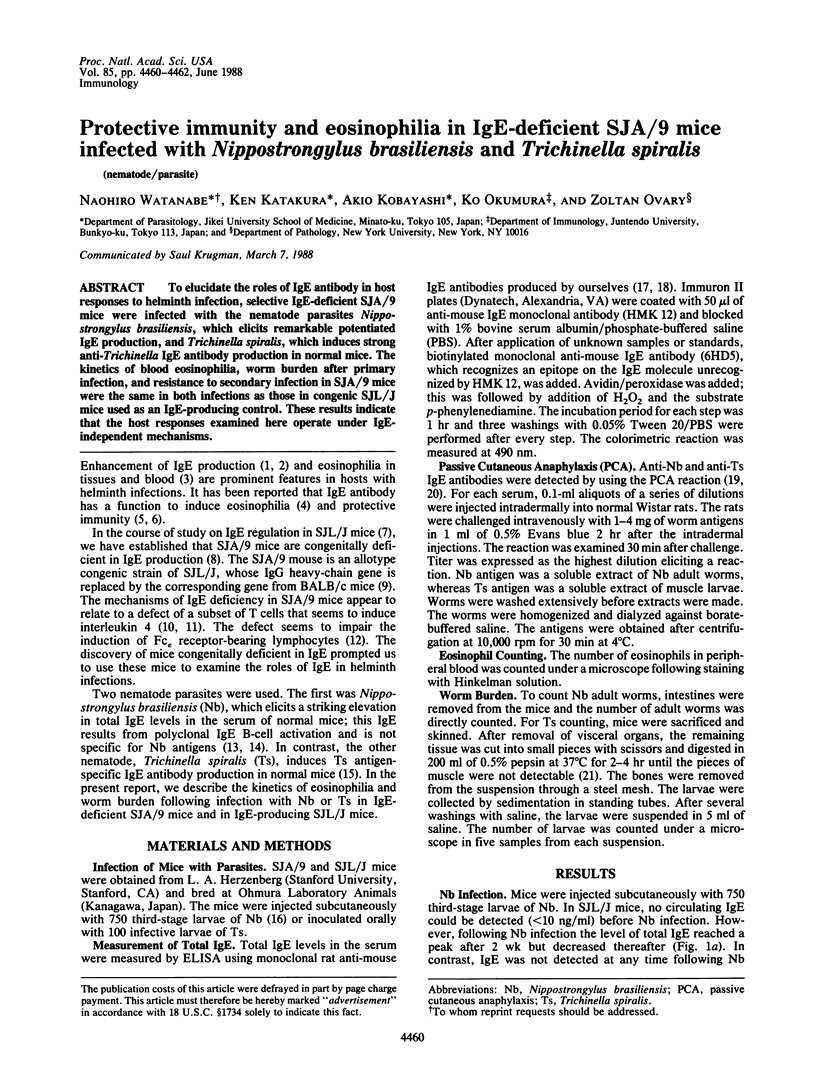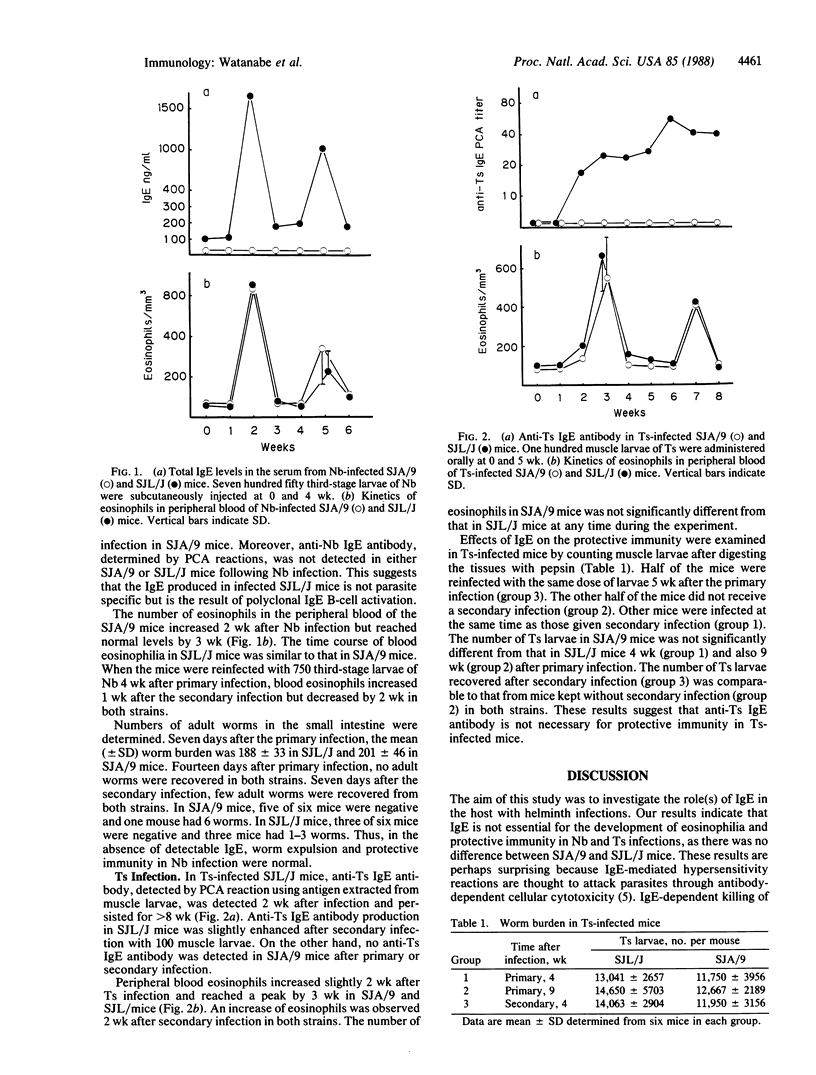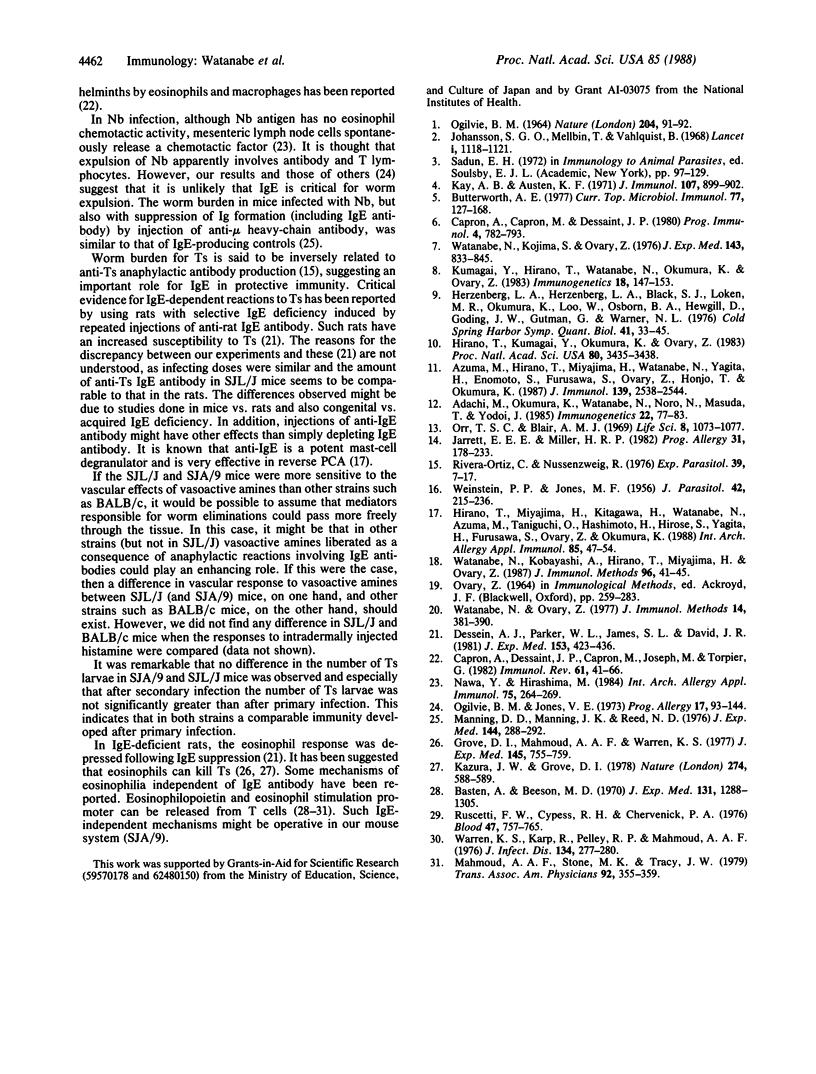Abstract
To elucidate the roles of IgE antibody in host responses to helminth infection, selective IgE-deficient SJA/9 mice were infected with the nematode parasites Nippostrongylus brasiliensis, which elicits remarkable potentiated IgE production, and Trichinella spiralis, which induces strong anti-Trichinella IgE antibody production in normal mice. The kinetics of blood eosinophilia, worm burden after primary infection, and resistance to secondary infection in SJA/9 mice were the same in both infections as those in congenic SJL/J mice used as an IgE-producing control. These results indicate that the host responses examined here operate under IgE-independent mechanisms.
Full text
PDF


Selected References
These references are in PubMed. This may not be the complete list of references from this article.
- Adachi M., Okumura K., Watanabe N., Noro N., Masuda T., Yodoi J. Lack of Fc receptor for IgE in SJA9 mice. Immunogenetics. 1985;22(1):77–83. doi: 10.1007/BF00430596. [DOI] [PubMed] [Google Scholar]
- Azuma M., Hirano T., Miyajima H., Watanabe N., Yagita H., Enomoto S., Furusawa S., Ovary Z., Kinashi T., Honjo T. Regulation of murine IgE production in SJA/9 and nude mice. Potentiation of IgE production by recombinant interleukin 4. J Immunol. 1987 Oct 15;139(8):2538–2544. [PubMed] [Google Scholar]
- Basten A., Beeson P. B. Mechanism of eosinophilia. II. Role of the lymphocyte. J Exp Med. 1970 Jun 1;131(6):1288–1305. doi: 10.1084/jem.131.6.1288. [DOI] [PMC free article] [PubMed] [Google Scholar]
- Butterworth A. E. The eosinophil and its role in immunity to helminth infection. Curr Top Microbiol Immunol. 1977;77:127–168. doi: 10.1007/978-3-642-66740-4_5. [DOI] [PubMed] [Google Scholar]
- Capron A., Dessaint J. P., Capron M., Joseph M., Torpier G. Effector mechanisms of immunity to schistosomes and their regulation. Immunol Rev. 1982;61:41–66. doi: 10.1111/j.1600-065x.1982.tb00373.x. [DOI] [PubMed] [Google Scholar]
- Dessein A. J., Parker W. L., James S. L., David J. R. IgE antibody and resistance to infection. I. Selective suppression of the IgE antibody response in rats diminishes the resistance and the eosinophil response to Trichinella spiralis infection. J Exp Med. 1981 Feb 1;153(2):423–436. doi: 10.1084/jem.153.2.423. [DOI] [PMC free article] [PubMed] [Google Scholar]
- Grove D. I., Mahmoud A. A., Warren K. S. Eosinophils and resistance to Trichinella spiralis. J Exp Med. 1977 Mar 1;145(3):755–759. doi: 10.1084/jem.145.3.755. [DOI] [PMC free article] [PubMed] [Google Scholar]
- Herzenberg L. A., Herzenberg L. A., Black S. J., Loken M. R., Okumura K., van der Loo W., Osborne B. A., Hewgill D., Goding J. W., Gutman G. Surface markers and functional relationships of cells involved in murine B-lymphocyte differentiation. Cold Spring Harb Symp Quant Biol. 1977;41(Pt 1):33–45. doi: 10.1101/sqb.1977.041.01.007. [DOI] [PubMed] [Google Scholar]
- Hirano T., Kumagai Y., Okumura K., Ovary Z. Regulation of murine IgE production: importance of a not-yet-described T cell for IgE secretion demonstrated in SJA9 mice. Proc Natl Acad Sci U S A. 1983 Jun;80(11):3435–3438. doi: 10.1073/pnas.80.11.3435. [DOI] [PMC free article] [PubMed] [Google Scholar]
- Hirano T., Miyajima H., Kitagawa H., Watanabe N., Azuma M., Taniguchi O., Hashimoto H., Hirose S., Yagita H., Furusawa S. Studies on murine IgE with monoclonal antibodies. I. Characterization of rat monoclonal anti-IgE antibodies and the use of these antibodies for determinations of serum IgE levels and for anaphylactic reactions. Int Arch Allergy Appl Immunol. 1988;85(1):47–54. [PubMed] [Google Scholar]
- Jarrett E. E., Miller H. R. Production and activities of IgE in helminth infection. Prog Allergy. 1982;31:178–233. [PubMed] [Google Scholar]
- Johansson S. G., Mellbin T., Vahlquist B. Immunoglobulin levels in Ethiopian preschool children with special reference to high concentrations of immunoglobulin E (IgND). Lancet. 1968 May 25;1(7552):1118–1121. doi: 10.1016/s0140-6736(68)90187-6. [DOI] [PubMed] [Google Scholar]
- Kay A. B., Austen K. F. The IgE-mediated release of an eosinophil leukocyte chemotactic factor from human lung. J Immunol. 1971 Sep;107(3):899–902. [PubMed] [Google Scholar]
- Kazura J. W., Grove D. I. Stage-specific antibody-dependent eosinophil-mediated destruction of Trichinella spiralis. Nature. 1978 Aug 10;274(5671):588–589. doi: 10.1038/274588a0. [DOI] [PubMed] [Google Scholar]
- Kumagai Y., Hirano T., Watanabe N., Okumura K., Ovary Z. Studies on IgE production in mice. I. Spontaneous suppression of IgE production in SJA/9 mice. Immunogenetics. 1983;18(2):147–153. doi: 10.1007/BF00368543. [DOI] [PubMed] [Google Scholar]
- Mahmoud A. A., Stone M. K., Tracy J. W. Eosinophilopoietin production: relationship to eosinophilia of infection and thymus function. Trans Assoc Am Physicians. 1979;92:355–359. [PubMed] [Google Scholar]
- Manning D. D., Manning J. K., Reed N. D. Suppression of reaginic antibody (IgE) formation in mice by treatment with anti-mu antiserum. J Exp Med. 1976 Jul 1;144(1):288–292. doi: 10.1084/jem.144.1.288. [DOI] [PMC free article] [PubMed] [Google Scholar]
- Nawa Y., Hirashima M. Regulation of eosinophilia in rats infected with Nippostrongylus brasiliensis. I. Eosinophil chemotactic factor produced spontaneously by mesenteric lymph node cells of infected rats. Int Arch Allergy Appl Immunol. 1984;75(3):264–269. [PubMed] [Google Scholar]
- OGILVIE B. M. REAGIN-LIKE ANTIBODIES IN ANIMALS IMMUNE TO HELMINTH PARASITES. Nature. 1964 Oct 3;204:91–92. doi: 10.1038/204091a0. [DOI] [PubMed] [Google Scholar]
- Ogilvie B. M., Jones V. E. Immunity in the parasitic relationship between helminths and hosts. Prog Allergy. 1973;17:93–144. [PubMed] [Google Scholar]
- Orr T. S., Blair A. M. Potentiated reagin response to egg albumin and conalbumin in Nippostrongylus brasiliensis infected rats. Life Sci. 1969 Oct 15;8(20):1073–1077. doi: 10.1016/0024-3205(69)90459-7. [DOI] [PubMed] [Google Scholar]
- Rivera-Ortiz C. I., Nussenzweig R. Trichinella spiralis: anaphylactic antibody formation and susceptibility in strains of inbred mice. Exp Parasitol. 1976 Feb;39(1):7–17. doi: 10.1016/0014-4894(76)90004-7. [DOI] [PubMed] [Google Scholar]
- Ruscetti F. W., Cypess R. H., Chervenick P. A. Specific release of neutrophillic- and eosinophilic-stimulating factors from sensitized lymphocytes. Blood. 1976 May;47(5):757–765. [PubMed] [Google Scholar]
- WEINSTEIN P. P., JONES M. F. The in vitro cultivation of Nippostrongylus muris to the adult stage. J Parasitol. 1956 Jun;42(3):215–236. [PubMed] [Google Scholar]
- Warren K. S., Karp R., Pelley R. P., Mahmoud A. A. The eosinophil stimulation promoter test in murine and human Trichinella spiralis infection. J Infect Dis. 1976 Sep;134(3):277–280. doi: 10.1093/infdis/134.3.277. [DOI] [PubMed] [Google Scholar]
- Watanabe N., Kobayashi A., Miyajima H., Hirano T., Ovary Z. Detection of IgE antibody-forming cells by passive cutaneous anaphylaxis using cell extract from lymphoid organs. J Immunol Methods. 1987 Jan 26;96(1):41–45. doi: 10.1016/0022-1759(87)90365-6. [DOI] [PubMed] [Google Scholar]
- Watanabe N., Kojima S., Ovary Z. Suppression of IgE antibody production in SJL mice. I. Nonspecific suppressor T cells. J Exp Med. 1976 Apr 1;143(4):833–845. doi: 10.1084/jem.143.4.833. [DOI] [PMC free article] [PubMed] [Google Scholar]
- Watanabe N., Ovary Z. Antigen and antibody detection by in vivo methods; a reevaluation of passive cutaneous anaphylactic reactions. J Immunol Methods. 1977;14(3-4):381–390. doi: 10.1016/0022-1759(77)90149-1. [DOI] [PubMed] [Google Scholar]


